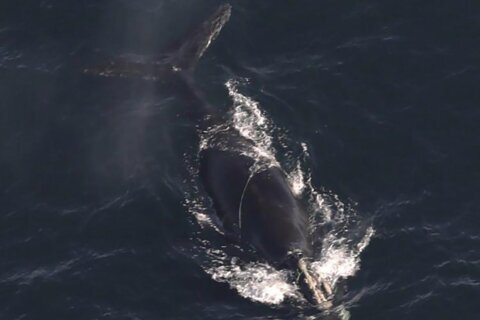Fifteen years after polar bears were listed as threatened, a new study says researchers have overcome a roadblock in the Endangered Species Act that prevented the federal government from considering climate change when evaluating impacts of projects such as oil and gas drilling.
The act requires agencies to ensure projects they approve don’t further harm listed species. But a 2008 Department of Interior legal opinion said greenhouse gas emissions didn’t have to be considered because the impact from specific projects couldn’t be distinguished from that of all historic global emissions.
A study published Thursday in Science’s Policy Forum says scientists for the first time are able to directly quantify the impact of human-caused greenhouse gas emissions from specific sources on polar bear cub survival.
It “just seems odd” that polar bears were listed because of the loss of sea ice due to global warming “but emissions have not been considered,” said lead author Steven C. Amstrup, chief scientist emeritus at Polar Bears International and a professor at the University of Wyoming.
Polar bears, which occur in 19 subpopulations throughout the Arctic, rely on sea ice to hunt for seals. As ice melts, they either end up on land or must swim farther from shore to find ice, which hurts their ability to find food and leads to long periods of fasting that deplete fat reserves. Human-caused global warming means there are fewer days of sea ice to help build up those reserves and longer fasting periods, and scientists have said most polar bears could become extinct by the end of the century unless warming is curbed.
A 2020 study found the number of fasting days, determined by the number of ice-free days every summer, directly affected cub survival. The new study, authors said, took that a step further and quantified the number of ice-free, fasting days caused by a specific amount of human-caused greenhouse gas emissions — distinct from what’s already in the atmosphere.
“What’s really relevant for policy is emissions,” rather than atmospheric concentrations, said co-author Cecilia M. Bitz, a climatologist and director of the climate change program at the University of Washington.
Researchers estimated the relationship between how long bears fasted and each gigaton of cumulative emissions, which they said allowed them to calculate the impact of emissions from specific projects on future polar bear cub survival.
“It’s basically connecting the dots” from emissions to ice-free days to impacts on polar bears, said Amstrup, who believes the method can be applied to many other species, such as sea turtles or coral reefs. He also believes the study makes a case for rescinding the 2008 opinion barring climate considerations, because the Endangered Species Act requires federal agencies to use the best available scientific data.
Interior officials could not be reached immediately for comment.
Todd Atwood, a wildlife biologist who leads the U.S. Geological Survey’s polar bear research program and was not involved in the study, said it is an important initial step in quantifying the relationship between greenhouse gas emissions and polar bear survival, and “is successful in the sense that it provides a framework for beginning to do that.”
But the lack of consistent estimates of population trends and survival rates for some polar bear subpopulations, which are distributed over a very large geographic area with differences in sea ice and food sources, can be “problematic when you’re trying to to match for recent greenhouse gas emission trajectories with population survival rates,” he said.
“This is not a critique of them, but … there’s a lot of subpopulations that are really hard to get to,” he said, adding that there’s not enough funding to do that.
Another expert believes the study shows a correlation between emissions and polar bear cub survival, but not a direct cause and effect.
“I think it takes us a little bit closer to understanding some of those relationships, but … I just don’t know that this paper pushes it over a new threshold,” said Andrew Derocher, a polar bear expert and biological sciences professor at the University of Alberta, who believes polar bears are at risk of extinction long-term. “I just don’t think that this is the smoking gun that is going to change opinion.”
Dan Rohlf, a professor at Lewis and Clark Law School in Portland, Oregon, and an expert on the Endangered Species Act, said the study makes important advances in understanding the effects of cumulative emissions on polar bears.
“I completely agree with the authors that it’s essentially ludicrous that … we list polar bears as threatened because of climate change, and then we turn around and say we can’t consider the impacts of these federal actions that will increase greenhouse gas emissions,” Rohlf said. “It makes no sense whatsoever.”
But federal agencies will only consider emissions from one project at a time — each of which would have relatively small impacts — and won’t account for cumulative emissions of federal actions, Rohlf said.
Agencies such as the Fish and Wildlife Service have the authority to determine that polar bears already are in jeopardy and that greenhouse gas emissions should be reduced, Rohlf said. Project evaluations then could consider whether emissions are consistent with a goal of reducing greenhouse gases — but “it wouldn’t fly politically.”
”The whole theory (now) is you keep allowing incremental adverse effects until the last one sort of is the straw that breaks the camel’s back and then you have to stop,” he said. “Well, if the camel’s back is already broken, we’ve got to stop now. And I think that’s the situation that we’re in for polar bears.”
___
Associated Press climate and environmental coverage receives support from several private foundations. See more about AP’s climate initiative here. The AP is solely responsible for all content.
Copyright © 2024 The Associated Press. All rights reserved. This material may not be published, broadcast, written or redistributed.






